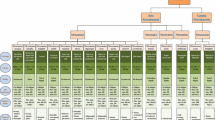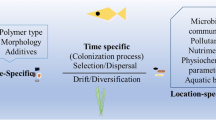Abstract
A lithotrophic ammonia-oxidizing bacterium of the Nitrosomonas type was isolated from the lower River Elbe. Enrichment was attained from suspended particulate matter (SPM) of a water sample. At its natural environment, this species almost exclusively occurred attached to flocs, as demonstrated with the immunofluorescence technique. On the species level, the isolate was not related to any of the described Nitrosomonas species. The strain was characterized by strong production of exopolymeric substances (EPS) and was observed to occur self-flocculating in pure cultures. Low ammonia concentrations stimulated EPS production. The EPS revealed an extensive capacity for binding particulate and dissolved materials, as well as cells of other bacterial species. This capacity was affected by changing pH values or salt concentrations of the medium. The EPS appeared to function as a buffer against toxic compounds and against changing environmental conditions. Another Nitrosomonas strain isolated from the Elbe estuary, but lacking recognizable EPS production, was used for comparison.
Similar content being viewed by others
References
Allison SM, Prosser JI (1991) Survival of ammonia oxidising bacteria in air-dried soil. FEMS Microbiol Lett 79:65–68
Allison SM, Prosser JI (1993) Ammonia oxidation at low pH by attached populations of nitrifying bacteria. Soil Biol Biochem 25:935–941
Bell CR, Albright LJ (1982) Attached and free-floating bacteria in a diverse selection of water bodies. Appl Environ Microbiol 43:1227–1237
Belser LW (1979) Population ecology of nitrifying bacteria. Ann Rev Microbiol 33:309–333
Belser LW Schmidt EL (1978) Diversity in the ammonia-oxidizing nitrifier population of a soil Appl Environ Microbiol 36:584–588
Bhuiya ZH, Walker N (1977) Autotrophic nitrifying bacteria in acid tea soils from Bangladesh and Sri Lanka. J Appl Bacteriol 42:253–257
Bohlool BB, Schmidt EL (1980) The immunofluorescence approach in microbial ecology. Adv Microbiol Ecol 4:203–241
Bremner JM (1965) Inorganic forms of nitrogen. In: Black CA (ed) Methods of soil analysis, American Society of Agronomy, Madison, Wisconsin pp 1179–1237
Brown MJ, Lester JN (1979) Metal removal in activated sludge: the role of bacterial extracellular polymers. Water Res 13:817–837
Brown MJ, Lester JN (1982) Role of bacterial extracellular polymers in metal uptake in pure bacterial culture and activated sludge. Water Res 16:1539–1548
Christensen BE, Kjosbakken J, Smidsrod O (1985) Partial chemical and physical characterization of two extracellular polysaccharides produced by marine periphytic Pseudomonas sp. strain NCMB 2021. Appl Environ Microbiol 50:837–845
De Boer W, Laanbroek HJ (1989) Ureolytic nitrification at low pH by Nitrosospira spec. Arch Microbiol 152:178–181
Decho AW (1990) Microbial exopolymer secretions in ocean environments: their role(s) in food webs and marine processes. Annu Rev Oceanogr Marine Biology 28:74–153
DeLey J, Cattoir H, Reynaerts A (1970) The quantitative measurements of DNA hybridization from renaturation rates. Eur J Biochem 12:133–142
Dugan PR, Pickrum HM (1972) Removal of mineral ions from water by microbially produced polymers. In: Proc 27th Ind Waste Conf Purdue Univ Engng Ext Ser No. 141:1019–1038
Ferris FG, Schultze S, Witten TC, Fyfe WS, Beveridge TJ (1989) Metal interactions with microbial biofilms in acidic and neutral pH environments. Appl Environ Microbiol 55:1249–1257
Geesey GG (1982) Microbial exopolymers: ecological and economic considerations. Am Soc Microbiol News 48:9–14
Koops HP, Harms H (1985) Deoxyribonucleic acid homologies among 96 strains of ammonia-oxidizing bacteria. Arch Microbiol 141:214–218
Koops HP, Möller UC (1992) The lithotrophic ammonia-oxidizing bacteria. In: Balows A, Trüper HG, Dworkin M, Harder W, Schleifer KH (eds) The prokaryotes, vol. 3. Springer-Verlag, New York, pp 2625–2637
Koops HP, Böttcher B, Möller UC, Pommerening-Röser A, Stehr G (1991) Classification of eight new species of ammonia-oxidizing bacteria: Nitrosomonas communis sp. nov., Nitrosomonas ureae sp. nov., Nitrosomonas aestuarii sp nov., Nitrosomonas marina sp. nov., Nitrosomonas nitrosa sp. nov., Nitrosomonas eutropha sp. nov., Nitrosomonas oligotropha sp. nov. and Nitrosomonas halophila sp. nov. J Gen Microbiol 137:1689–1699
Lewis ER, Jackson L, Scott T (1975) Comparison of miscibilities and critical-point drying properties of various intermedial and transitional fluids. In: Johari O, Corvin J (eds) Scanning electron microscopy. IITRI, Chicago, pp 317–324
Marshall KC, Bitton G (1980) Microbial adhesion in perspective. In: Bitton G, Marshall KC (eds) Adsorption of microorganisms to surfaces. John Wiley & Sons, New York, pp 1–5
Martikainen PJ, Nurmiaho-Lassila EL (1984) Nitrosospira, an important ammonium-oxidizing bacterium in fertilized coniferous forest soil. Can J Microbiol 31:190–197
Meincke M, Krieg E, Bock E (1989) Nitrosovibrio spp., the dominant ammonia-oxidizing bacteria in building sandstone. Appl Environ Microbiol 55:2108–2110
Olson RJ (1981) 15N tracer studies of the primary nitrite maximum. J Mar Res 39:203–226
Palumbo AV, Ferguson RL, Rublee PA (1984) Size of suspended bacterial cells and association of heterotrophic activity with size fractions of particles in estuarine and coastal waters. Appl Environ Microbiol 48:157–164
Prosser JL (1989) Amotrophic nitrification in bacteria. Adv Microb Physiol 30:125–181
Rees DA (1976) Stereochemistry and binding behavior of carbohydrate chains. In: Whelan WJ (ed) Biochemistry of carbohydrates, vol. 5. University Park Press, Baltimore, pp 1–42
Rendelman JA (1978) Metal-polysaccharide complexes, Part I. Food Chem 3:47–79
Rudd T, Sterrit, RM, Lester JM (1983) Mass balance of heavy metal uptake by encapsulated cultures of Klebsiella aerogenes. Microb Ecol 9:261–272
Suwa Y, Imamura Y, Suzuki T, Tashiro T, Urushigawa Y (1994) Ammonia-oxidizing bacteria with different sensitivities to (NG4)2SO4 in activated sludges. Water Res 7:1523–1532
Unanue M, Ayo B, Azua I, Barcina I, Iriberri J (1992) Temporal variability of attached and free-living bacteria in coastal waters. Microb Ecol 23:27–39
Uncles RJ, Stephens JA (1993) Nature of the turbidity maximum in the Tamar Estuary, U.K. Estuarine Coastal Shelf Sci 36:413–431
Walker N, Wickramasinghe KN (1979) Nitrification and autotrophic nitrifying bacteria in acid tea soils. Soil Biol Biochem 11:231–236
Ward BB (1986) Nitrification in marine environments. In: Prosser JI (ed) Nitrification. IRL Press, Oxford, England, pp 157–184
Watson SW, Mandel M (1971) Comparison of the morphology and deoxyribonucleic acid composition of 27 strains of nitrifying bacteria. J Bacteriol 107:563–569
Zimmerman R, Meyer-Reil LA (1974) A new method for fluorescence staining of bacterial populations on membrane filters. Kiel Meeresforsch 30:24–27
Author information
Authors and Affiliations
Additional information
Correspondence to: G. Stehr
Rights and permissions
About this article
Cite this article
Stehr, G., Zörner, S., Böttcher, B. et al. Exopolymers: An ecological characteristic of a floc-attached, ammonia-oxidizing bacterium. Microb Ecol 30, 115–126 (1995). https://doi.org/10.1007/BF00172568
Received:
Revised:
Issue Date:
DOI: https://doi.org/10.1007/BF00172568




